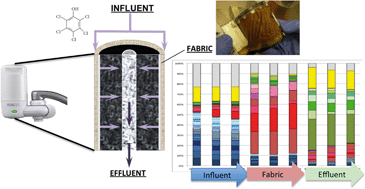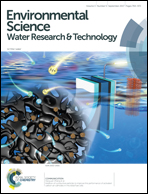The microbial colonization of activated carbon block point-of-use (PoU) filters with and without chlorinated phenol disinfection by-products†
Abstract
Activated carbon block (ACB)-based point-of-use (PoU) drinking water filters are widely used to remove residual disinfectant, heavy metals, and disinfection by-products (DBPs) from household tap water. The filters are not designed to remove bacteria, which can grow in the filter. Based on previous research, we hypothesized that more biofilm would form in PoU filters due to the presence of chlorinated phenolic DBPs, resulting in higher bacterial concentrations in filtered water. Therefore, studies were conducted by operating a manifold system with three sets of ACB PoU filters that received chloraminated tap water spiked with (50 and 100 ng L−1 added) and without (0 ng L−1 added) pentachlorophenol (PCP) as a surrogate chlorinated phenolic DBP. After processing 85% of the manufacturer's recommended water volume, effluent heterotrophic plate counts plateaued at levels up to 100 times greater than influent counts. The upstream filter fabric developed a significant biofilm that lightened with increasing PCP concentration; however, the overall biofilm mass was not different between treatments. Influent, effluent, and fabric samples had distinct bacterial community structures, and the structure of effluent communities was more similar to that of fabric communities than that of influent communities. The bacterial community structure changed across the filter primarily due to the filter environment itself, while PCP effects were subtle yet significant. The relative abundance of Mycobacterium increased within fabric biofilms when PCP was added, and the absolute abundance was estimated to increase in the effluent relative to the influent. In conclusion, ACB PoU filters significantly alter the bacterial abundance and composition of drinking water.



 Please wait while we load your content...
Please wait while we load your content...